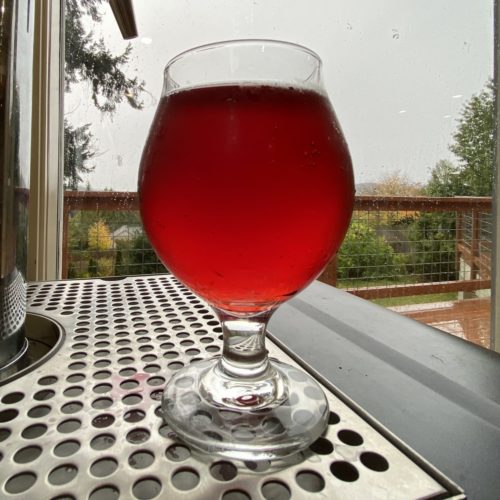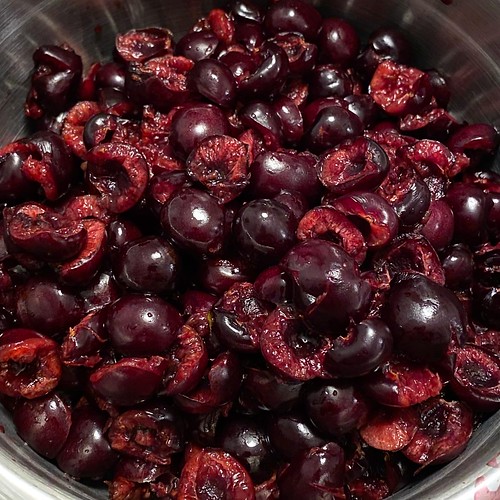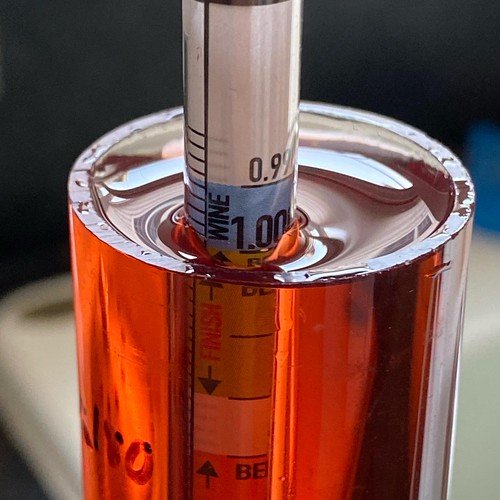Homebrew #106: First Avenue Crow
¶ by Rob FrieselIt was cherry season in Washington, and our household had been eating the crap out of some Rainier cherries. When it occurred to me that I hadn’t worked with whole cherries in a mead 1 before, there was only one thing to do. Fire up the ol’ mead making machine that is me, get a few pounds of fruit, and make an as-inspired-by version of Psychopomp and call it First Avenue Crow. 2

{{ ANYTHING ELSE? inspiration? prep? }}
Brew Day
I’ll keep this one mercifully short. The actual must-making was pretty standard stuff and if you’ve read my mead-making posts in the past then you know it’s basically just mixing up honey and warm water until I’ve got the right volume. The only three “interesting” bits:
- I added some calcium chloride, thinking I could soften the mouthfeel a bit in the finished product.
- I added all the yeast nutrient up-front because.
- It was Mead Day 2020 and maybe I wasn’t going to be able to do a live demo like the past couple years, but I’ll be damned if I was going to miss it all together.
Anyway here’s a picture of the must.

O.G. 1.050
Fermentation
Rehydrated some 71B with some GoFerm and pitched. Fermentation was active sometime before +14 hours which is when I bothered to check up on it.
Approximately 48 hours into fermentation, I acquired 6 lb. of local Rainier cherries… 3

…and processed them…

…and added them to the must.

For the next week, I degassed and punched down the cap at least once a day. After that week, the cherries were well-blanched, and the mead was quite red.

I racked the mead off of the cherries, and let it settle, clarify, and condition for about another month until I put it in a keg. Once kegged, I put it on-gas at 12 PSI for 8 days before letting it condition another approx. 2 weeks before serving.

Overall Impressions

BOUQUET/AROMA. Moderately strong fruity aromas lead — semi-sweet cherry is distinct and dominant. Honey impression is very low, and comes across as lightly floral. Just-above-threshold ethanol. If there’s any fermentation character, then it’s esters that overlap with the cherry notes. Not one-dimensional, but also pretty low-complexity — suitable for a hydromel. Background sulfur notes but those blow-off relatively quickly.
APPEARANCE. Vivid red. Very light haze (not cloudy), but otherwise good clarity — and almost gem-like in a tulip glass. Pinkish foam from a draft pour forms into tightly beaded mousse upon pouring but rapidly dissipates into a thin cordon before disappearing entirely. A few noticeable bubbles, all of them tiny. No significant legs.
FLAVOR. Leads semi-sweet. Distinct cherry notes pronounced throughout. Light tannic astringency in the mid-palate and finish. Acidity is moderately low; notably tart, but not mouth-puckering. Honey character is not significant: low floral, indistinct. Dry finish with noticeable ethanol that enhances the palate-drying impression. Mildly fruity esters, but (again) those blend in with fruit character. Some moderately low bitterness — likely ethanol and tannins. Significant carbonation, but not Champagne-like or mouth-filling. Body is light but not thin. Aftertaste is relatively short and has a tannic quality likely imparted by the fruit skins. Ethanol is detectable but low, and not out-of-style. With the acidity and tannic finish, the balance tilts to the fruit, but could use a little more sweetness to round it out.
OVERALL IMPRESSION. A pleasant but unremarkable cherry mead. While not particularly complex, a straightforward hydromel-strength mead doesn’t need to be. That said, while the acidity and tannins seem in balance with one another, the mead overall could use more sweetness to enhance drinkability. Clarity might also be improved through longer conditioning, the addition of pectinase, or perhaps fining agents.
…and on the note: what would I change? Well, for starters, I have ideas about how to enhance the sweet impression without necessarily abandoning the conceit of this as a dry mead. Given that Rainier cherries are a kind of semi-sweet cherry to begin with, it seems that some of that impression was lost to fermentation. The addition of some vanilla during conditioning could enhance the perception of sweetness, without actually resorting to backsweetening.
That being said, while the sweetness needs to be boosted for the sake of the overall balance, I also think that to do so might also benefit from boosting the tannins slightly. I would consider keeping the pits from â…“ to ½ the cherries next time.
A more complex honey varietal might also help. I tend to use inexpensive wildflower honey for my I’m-just-drinking-it-at-home meads anyway, but for whatever reason, this one seems like it could stand some more character that.
In the meantime: it is a totally drinkable mead, and I’ll enjoy having it around to drink, though I doubt very much that I’d send any to competition. Oh — and a shot of triple sec transforms it into a very grown-up Hawaiian Punch.
Recipe
The recipe for First Avenue Crow is as follows:
Water Chemistry
Starting with the Seattle municipal water profile (carbon filtered) as a base:
| Ca | Mg | Na | SO₄ | Cl⁻ | HCO₃⁻ |
|---|---|---|---|---|---|
| 64 | 1 | 2 | 2 | 103 | 23 |
1 tsp calcium chloride per 5 gallons
Fermentables
- 6 lb. wildflower honey
- 6 lb. Rainier cherries
Yeast
2 sachets (5 g ea.) Lalvin 71B; rehydrate with Go-Ferm nutrients.
Brew Day
- Collect 20 qt. water and heat to 90ºF. Add 3 gal. to fermentation vessel. Add 5 crushed Campden tablets and 2.5 tsp yeast nutrient to fermentation vessel. Stir to mix until dissolved.
- Add 6 lb. of wildflower honey to fermentation vessel. Stir to mix until dissolved. Top up to 5 gallons and stir to homogenize.
- Allow must to cool to pitching temperatures.
- Rehydrate 2 sachets (5 g ea.) of Lalvin 21B in 250 ml water with 12.5 g of Go-Ferm. Pitch and aerate must.
- Start fermentation in the mid-60s ºF.
Beyond Brew Day
- At approx. +48 hours post-pitch, add the cherries. Prepare cherries: de-stem and pit the cherries; soak them in a clear neutral spirit (e.g., vodka) for a few minutes before setting aside. After all cherries are prepared, add them directly to the fermenting must.
- Leave the cherries in contact with the fermenting must for approx. 7 days. At least once per day, degas the must and punch down the cap to keep the fruit hydrated and inhibit microbial growth.
- After approx. 7 days, rack the mead off of the fruit to a separate vessel. Allow the mead to condition for at least 2 more weeks before packaging.
- Rack to a keg. Force carbonate to approx. 2.3 volumes.
- Enjoy!
Details
First Avenue Crow, a cherry mead by Tilde Gravitywerks
| Original Gravity | 1.050 |
| Final Gravity | 0.999 |
| ABV | 6.7% |
| Attenuation | 102.1% |
| Links | Flickr |
- Or a beer, for that matter.[↩]
- The crow part is an obvious (??) callback to the Psychopomp can design. The “First Avenue” part comes from the fact that First Avenue in Phinney Ridge was simply overrun with them in the summer of 2020 and we got dive-bombed, followed, or otherwise harassed by those corvids on more than one occasion.[↩]
- Although I’ll also admit, looking at these photos now… I’m less certain that they were actually Rainier cherries. I thought that’s what the bag said but these might actually be Bings…[↩]
Leave a Reply